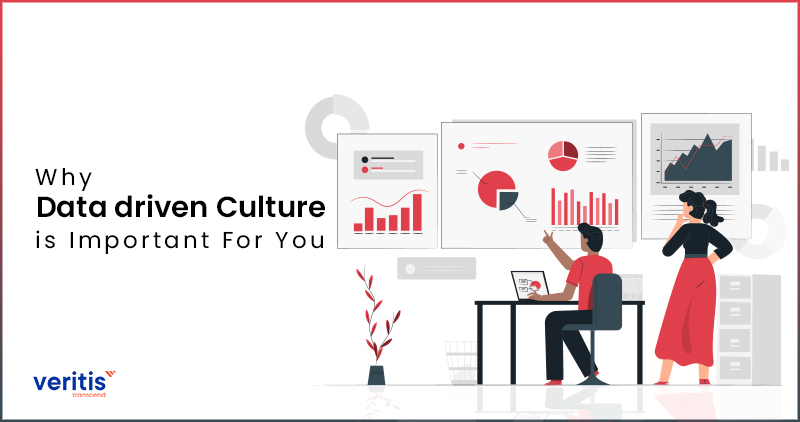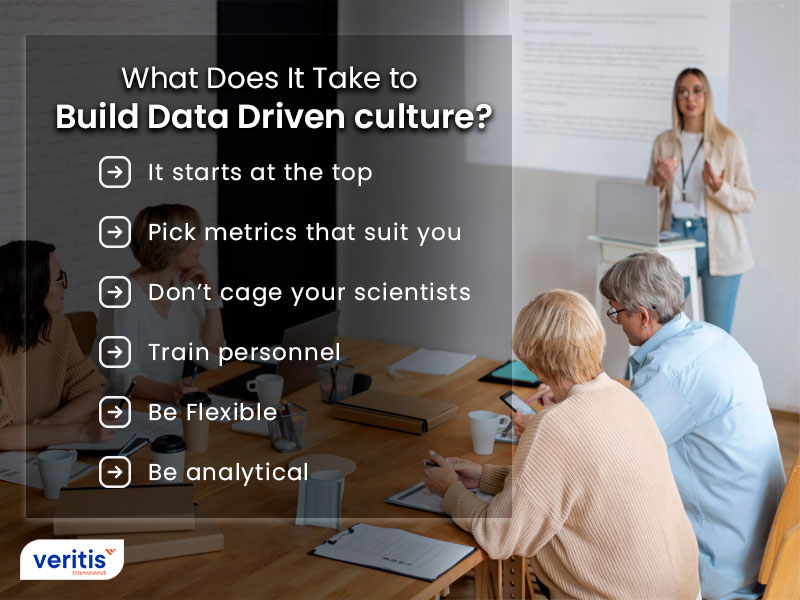
In an increasingly volatile and competitive U.S. market, C-suite executives must make faster, smarter, and more strategic decisions. This is where a data driven culture becomes indispensable. By embedding data into every aspect of decision-making, from forecasting to customer experience, top-performing organizations are unlocking new growth opportunities and operational efficiencies. However, the flip side is that not leveraging data could mean missing out on these opportunities and falling behind the competition. It’s the responsibility of every leader to ensure that data is utilized to its full potential. According to IDC, global data is projected to reach 175 zettabytes by 2025. However, it’s not the volume of data that defines success; it’s how leaders use it to drive measurable impact.
Companies are embracing a data driven approach to stay ahead of their competition and to achieve results after seeing how data trends are upending whole marketplaces. As a result, various companies are embracing data driven culture, and these data driven companies “are increasing at an average of more than 30% yearly,” according to a Forrester analysis.
Talk to Our Data Integration Expert
What Is a Data Driven Culture and Why Should C-Suite Executives Care?

Taking chances typically pays off in business, but businesses should refrain from seizing opportunities at any cost. The data driven culture comes to the rescue at this scene. Data driven strategy approach is a method of utilizing data insights to find new business possibilities, provide better customer service, increase sales, and more. It enables firms to carefully prepare and make decisions based on facts to fulfill their business objectives.
A data driven choice is supported by empirical facts, allowing executives to make wise decisions that favorably impact the company’s bottom line. A decision-making process primarily based on guesswork is the antithesis of one that is data driven. Data driven company executives may consult their instincts when making decisions, but they only take precise measures in response to what the data driven culture pulls up.
A data driven choice is supported by empirical facts, allowing executives to make wise decisions that favorably impact the company’s bottom line. A decision-making process primarily based on guesswork is the antithesis of one that is data driven. Data driven company executives may consult their instincts when making decisions, but they only take precise measures in response to what the data shows.
For senior executives, building a culture centered on data is no longer optional; it is essential. It’s essential for staying competitive. Research highlights that organizations that leverage data effectively see significantly higher success in attracting and retaining customers. By harnessing real-time analytics, leaders such as CEOs, CIOs, and CTOs in the United States can better anticipate challenges, reduce uncertainty, and uncover growth opportunities that might otherwise go unnoticed. Yet, the actual transformation lies not in adopting technology alone but in reshaping organizational culture, starting with committed leadership at the top. Your role in this shift is crucial and must begin without delay.
If the insights from the data driven approach do not disclose anything, the data driven framework is of little to no value in and of itself. The value comes from what is done with the data, not from the data itself. Data analytics, or analyzing data to get business insights, is a valuable tool for firms driven by data. The information may then be used to improve operations or solve problems in the corporate world. Data driven insights are valuable because it empowers executives to make well-informed decisions that may improve operations, boost productivity, and forge closer bonds with clients.
Also Read: AI Reshaping Future of Data Center Industry – Google Shows How?
What Are the Biggest Challenges in Building a Data Driven Culture for C-Level Executives?

Although the benefits of a data driven organization are numerous, creating a data driven culture has sometimes been challenging. Recent research by NewVantage Partners revealed that businesses’ attempts to adopt data driven culture are failing. According to the research, 72% of survey respondents, primarily C-level executives (97.5%), said their firms still needed to establish a data driven culture. As a result, we’re witnessing a dismal digital retreat rather than an increased digital revolution.
It may be helpful to compare your company’s data consumption to your smartphone usage if you’re trying to determine the magnitude of your data driven culture. Today, most people would be upset if their phones were lost for a long time. However, most of us only understand how reliant on these gadgets (and their applications) we are once they break or disappear. What would happen if your team couldn’t access your data for a whole day in a similar way? What about a full week? What would your organization’s response score on the following scale be if you were to rate it?
Also Read: 4 Key Areas to Apply Data and Analytics in Digital transformation (DX)
How Can C-Suite Leaders Build and Sustain a Data Driven Culture?

When employees understand the driving metrics for which they are accountable and how those metrics affect the Key Performance Indicators or KPIs, a firm is said to have a data driven approach. Data needs to be made more accessible to the general public, or “democratized,” in other words. Employees must comprehend data and apply it to make appropriate decisions for their responsibilities within the organization. Citizen analysts are required, as they can do fundamental analyses without the assistance of a data staff. When all workers use the same data to inform their choices, the business also requires a Single Source of Truth. To keep data uniform, accurate, usable, and secure, it must have data governance and master data management.
A corporation is more data driven culture reliant if these indicators are better. These may appear complicated, but they are not. These elements will fall into place after you properly begin your data driven approach journey.
Data driven approach is not, however, a one-time endeavor that can be abandoned after completion. Data maturity, data driven Leadership, data literacy, and Decision-making process are the four pillars of a data driven culture. Therefore, when creating a data driven framework, these 4Ds are crucial.
However, the underlying culture is the biggest challenge to the data driven approach. Therefore, we have condensed the critical steps to develop and maintain a culture with data at its heart.
- It starts at the top: Top managers in organizations with a robust data driven model frequently create the expectation that data must support choices and that doing so is a standard procedure rather than anything unusual or innovative. They set an example by doing. C-suite executives at one retail bank collectively evaluate the data from controlled market trials to make decisions about product releases. At a top IT company, senior executives study in-depth summaries of ideas and the data supporting them 30 minutes before meetings so they may act on the information. As a result, data driven company employees who want to be regarded seriously must speak to top executives on their terms and using their language. As a result, these habits spread downward. Significant changes in company-wide standards can be catalyzed by the example set by a select few at the top. Particularly when backed by efficient data integration services guaranteeing simple access to dependable information.
- Pick the metrics that suit you: Leaders may significantly impact how people behave by carefully selecting what to track and the metrics they want their team members to utilize. A data driven company can benefit by predicting pricing changes made by rivals. Predictive accuracy over time is a statistic that may be used to measure this. Therefore, a team should constantly make specific forecasts regarding the size and direction of such shifts. The accuracy of those forecasts should also be monitored because they will improve over time.
- Don’t cage your Scientists: Businesses not only push data science closer to the company but also pull the business toward data science, primarily by requiring that staff have a strong understanding of coding and quantitative concepts. There is no need for senior executives to reincarnate as machine-learning engineers.
- Train Personnel: Many businesses spend on “big bang” training initiatives, but if workers don’t immediately use what they’ve learned, they quickly forget it. Therefore, while foundational training of the data-driven company should include basic skills like coding, it is more efficient to teach workers in advanced analytical ideas and tools only before they are required, such as a proof of concept. One store only trained its support analysts on the finer parts of experimental design just before a first market trial. The data driven solutions knowledge persisted, and now analysts use words like statistical confidence that were formerly foreign to them.
- Be Flexible: Numerous data driven culture businesses that rely on data are home to various “data tribes.” Each may have preferred information sources, custom metrics, and programming languages. This may be disastrous for a whole company. Trying to reconcile somewhat divergent interpretations of a measure that ought to be standard can cost businesses endless hours. Consistency issues in modelers’ work also have an impact. Every move by analytical talent requires retraining if coding standards and languages differ throughout a corporation, making it challenging for them to move around. If ideas always require translation, discussing them within might be difficult. Instead, businesses should use standard measurements and programming languages. One international central bank achieved this by requiring Python coding skills from investment banking and asset management recruits.
- Be Analytical: Rarely is there a single, ideal strategy for most analytical issues. Data driven solutions scientists must instead make decisions involving various tradeoffs. It’s a good idea to ask teams how they solved an issue, what options they thought about, what they thought the tradeoffs were, and why they decided on one solution over another. Teams gain a more excellent knowledge of the techniques by doing this often, frequently inspiring them to think about other options or reevaluate underlying presumptions. One primary provider of financial services initially believed that a machine-learning model to detect fraud couldn’t operate swiftly enough to be employed in production. However, it was later discovered that the model could be made quickly with a few adjustments. When the business started using the model, it saw astounding improvements in detecting fraud.
Also Read: Data Strategy – A Key Checklist for Digital Transformation
What Do the Latest Stats Reveal About Data Driven Culture in 2025?
In today’s highly competitive and tech-driven environment, the importance of a data driven culture is reflected in recent statistics:
- Only 19% of executives say their companies have successfully created a data driven culture. (NewVantage Partners, 2024)
- Despite significant investments, a staggering 72% of companies are yet to fully embrace a data-driven approach, highlighting the urgent need for change in the business landscape.
- It’s a global trend: 88% of enterprises are actively undergoing AI or data transformation efforts, marking a significant movement in the business world. (McKinsey, 2025)
- Companies with robust data driven practices are 23 times more likely to acquire customers and 6 times more likely to retain them, paving the way for significant growth and success. (McKinsey Global Institute)
How C-Suite Leaders Drive a Data Driven Culture?
For a data driven culture to succeed, it must be championed from the top. In U.S. enterprises, C-suite executives are not just stakeholders. They are the catalysts, empowered to drive change. From setting expectations around data-backed decisions to investing in scalable analytics infrastructure, executives must lead by example. Research from NewVantage Partners shows that although 97.5% of executives aspire to be data-driven, only a fraction have succeeded, highlighting a critical leadership gap. A data-first mindset at the leadership level fosters accountability, alignment, and long-term business value, making the C-suite executives integral to the process.
Case Study Highlight: Financial Performance Optimization through Data-Driven Insights
A leading real estate services firm partnered with Veritis to harness the power of comprehensive Business Intelligence (BI) solutions. These solutions didn’t just process data; they transformed their financial and HR data into actionable insights, empowering the firm with a new level of understanding and control.
Challenge:
The client faced significant data discrepancies and limitations in data visualization across their financial and HR systems, hindering accurate reporting and analysis.
Veritis’ Solution:
- Conducted a thorough audit of existing data systems to identify inconsistencies
- Implemented BI tools to integrate and cleanse data from PeopleSoft Finance and HR systems
- Developed intuitive dashboards for real-time financial and HR reporting
- Provided training to empower stakeholders in data-driven decision-making
Impact:
- Enhanced data accuracy and consistency across departments
- Enabled real-time, actionable insights for better strategic planning
- Improved operational efficiency and decision-making processes
- Achieved a return on investment of over $13 for every dollar spent
Explore the complete case study: Financial Performance Optimization and myHR Analytics for Real Estate Services Client.
Final Thoughts
Data may offer evidence to support assumptions, enabling managers to go into new processes and areas without taking a blind leap. However, more than merely wanting to be data-driven is required. Data-driven companies must create environments where this thinking may flourish if they want to be data-driven. Leaders may model this transformation for others by adopting new behaviors and setting standards for what it means to base choices on facts. However, modeling a data-driven approach is easier than it seems, as it is a cultural shift one must embrace. This is where Stevie Award winner Veritis comes to your rescue. We understand your requirements and will help you transition seamlessly. Contact us for data integration solutions that are better than your competition’s.
Consult for Data Integration Solutions
More Articles: